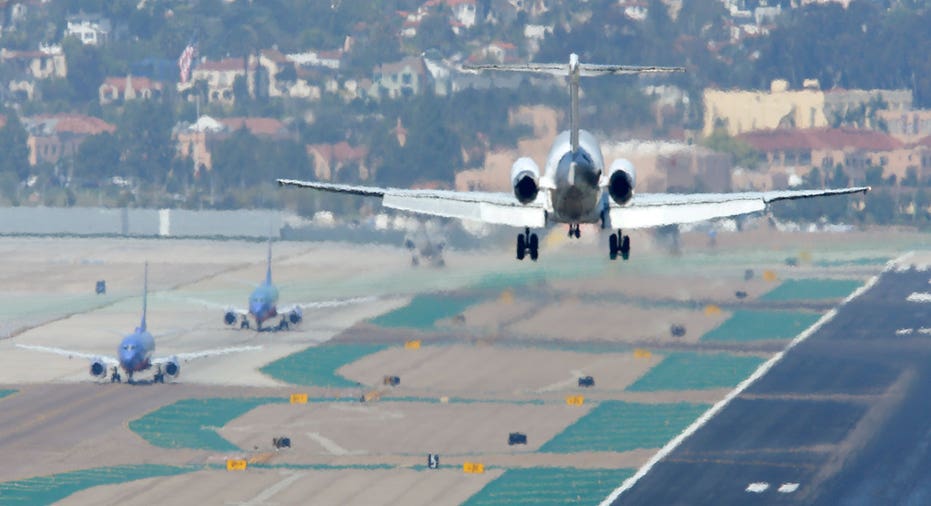America’s Air Traffic Control System is Finally Going Digital

Imagine you're at the airport when a thunderstorm hits, only instead of hours of delays, and a messy overnight rerouting through Wichita, your plane is smoothly redirected on a minor detour and you arrive home in Cincinnati only 10 minutes behind schedule, greeting your bags on the carousel and your kids at the dinner table.
That's the dream of the Federal Aviation Administration, which is about a third of the way through a massive overhaul of America's air traffic control system. Instead of the cumbersome radar and radio system used to direct airplanes that's been in place for more than half a century, the FAA's NextGen control system relies on an array of digital technology linking satellite-based GPS systems directly to the cockpits of jets anywhere in the U.S.
With the FAA handling some 90,000 flights a day, and the number expected to grow to 125,000 by 2035, airlines and regulators want to move away from the current ground-based radar system as quickly as possible. Work on NextGen began in 2007 aiming for completion by 2030 at a total cost of $32 billion. Of that, $17 billion will come from the FAA via passenger ticket and other fees, with airlines and other plane owners spending about $15 billion to equip their aircraft with updated technology.
The FAA has already installed the first phase of NextGen, called ERAM, the En Route Automation Modernization system. It lets air traffic controllers track 1,900 aircraft at a time, up from 1,100, and lets all 20 flight control centers have access to all flight plans filed in the system. It gives controllers the exact position and altitude of each plane in the air literally every second, replacing radar updates that occurred only every seven to 12 seconds. That's saving airlines - and passengers - money by allowing planes to fly more direct routes, and fly closer together. Delays are reduced and the need for expensive new runways is also reduced - or at least postponed.
The need for a new control system is real: in 2014, U.S. passenger airlines lost $9.1 billion to delays, including $4.3 billion in extra fuel, according to government data compiled by the Airlines for America, a lobbying group for the industry. Add in the value of lost time for passengers and that sum could triple, according to a 2010 study by the FAA that estimated delays in 2007 alone cost the U.S. economy $32.9 billion.
Airlines and the FAA agree that it's impossible to build enough new airports and runways to satisfy the expected growth in air traffic over the next several decades, which leaves only one way out: run more flights, more often and take less time to get planes from one city to the next.
Not everyone is happy with the way things are going. Airlines complain of delays and high costs with NextGen, and Airlines for America wants the government out of the air traffic business, replaced by a private, not-for-profit corporation, much like Nav Canada, which runs air traffic north of the U.S. border. "They've been working on NextGen for 10 years and spent $6 billion and they don't have anything to show for it," said Sharon Pinkerton, the group's senior vice-president for policy and regulatory affairs. House Transportation Committee Chairman Bill Shuster (R-Penn.) is working on a bill to end the FAA's role.
The FAA has in fact been rolling out NextGen in phases, as it perfects the technology, receives funding from Congress and as airlines install receiving equipment in their planes. In May, a computerized messaging system was unveiled that should speed communication between control towers and pilots.
The new system, called Data Comm, kicks in when bad weather or delays mean planes need to change their flight plans. It sends new routes directly to planes awaiting takeoff, and heading toward bad weather. Currently, controllers read the new instructions to pilots over the radio, and it can take several minutes for a pilot to confirm his new route by voice, and then manually enter it into the plane's flight computer. The FAA hopes to have Data Comm in place at 56 airports by the end of 2016, the AP reported.
Already, computer-generated flight paths that use GPS tracking let airlines fly straighter routes cutting trip lengths by as much as 12% to 15%, said Pinkerton. That's money that helps the bottom line of airlines and reduces time lost by passengers.
Still, the airline group says Congress's inability to ensure regular funding for NextGen and what it calls a burdensome federal bureaucracy mean the FAA should leave air traffic control to the industry and other stakeholders and let the FAA focus on safety and training.
"Stable, predictable funding is an essential next step for Congress," said Paul Rinaldi, president of the National Air Traffic Controllers Association, who noted the country is running out of controllers as government shutdowns interfere with hiring.
The growth of drones may also upset the plans for NextGen. Unmanned aircraft, especially full-sized planes flying in commercial airspace, weren't part of the plan when NextGen was first devised, FAA officials said last year.
Airlines aren't the only people who aren't fans of NextGen's new, fuel-efficient landing patterns. In Phoenix, one of a handful of cities already plugged in to the NextGen system, new flight paths meant to ease air traffic congestion and save fuel have so angered residents who now live under the constant noise of approaching aircraft, that Mayor Greg Stanton announced in June he's suing the FAA. Residents of Chicago, Boston and New York have also complained about noise from new flight paths, the AP reported.



















